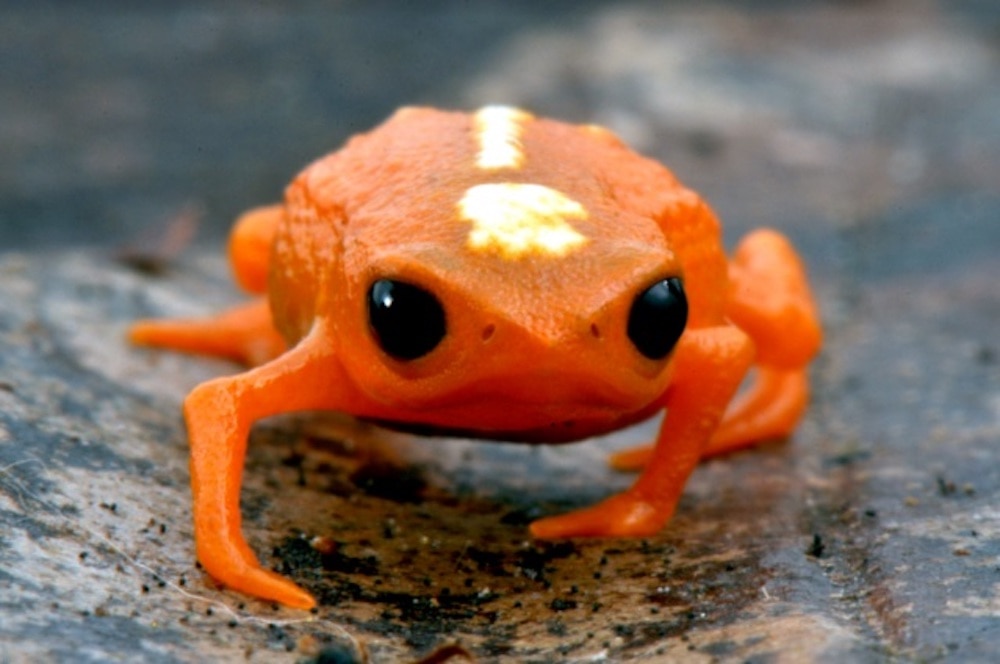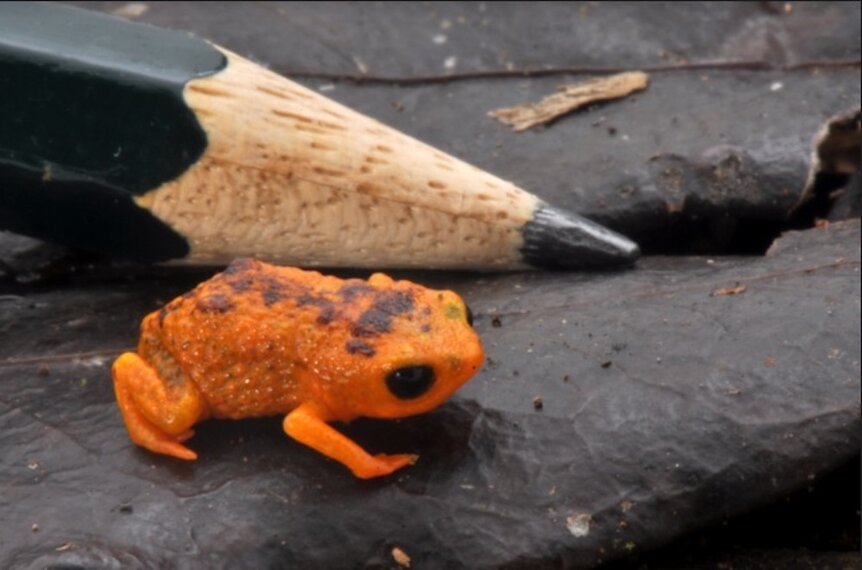Create a free profile to get unlimited access to exclusive videos, sweepstakes, and more!
Jumping is sort of a key feature of frogs, so why are pumpkin toadlets so terrible at it?
When you have hundreds of frog species, they can't all be winners.

Halloween of 2016 brought us a new holiday character who was more confusing than terrifying. We’re talking about David S. Pumpkins, and we still have so many questions. With his skeleton sidekicks, he made dressing like a pumpkin with a curly wig and double-holstered finger guns one of the top Halloween costumes that year.
The pumpkin toadlet, however, has been dressing like a pumpkin since before recorded history. These fluorescent orange frogs are the world’s smallest and most adorable jack-o-lanterns. They’re also perhaps the world’s worst jumpers. When they get scared — whether from an undead bride or a natural predator — pumpkin toadlets leap into the air before making an entirely uncontrolled crash landing.
Jumping is sort of a key feature of frogs so it’s unusual that they’re so terrible at it. That’s why Richard Essner Jr. from the Department of Biological Sciences at Southern Illinois University, and colleagues, were interested in them and set out to figure out why they’re such awful acrobats. Their findings were published in the journal Science Advances.
“I’ve been working on jumping for a long time and eventually started thinking about landing behavior. I was interested in trying to find something, a group that might have ancestral behavior and morphology that would allow me to get a better idea of what jumping looked like when it first emerged,” Essner Jr. told SYFY WIRE.
The research led him to a group of tailed frogs in the Pacific Northwest of the United States, and their closest relatives in New Zealand. They branched off from the rest of frogs about 200 million years ago and could jump but couldn’t control the landing. Scientists pinned the tailed frog behavior on an evolutionary holdover from a time after powered jumping evolved, but before frogs figured out how to stick the landing. Then Essner Jr. got a look at the pumpkin toadlet, a miniature frog from Brazil.
“It was really similar to what I’d seen in the tailed frogs and the New Zealand frogs, and it didn’t make a lot of sense. These little frogs are well within the larger group of frogs that are really good at jumping. So, we were trying to figure out why their landing behaviors is so similar,” Essner Jr. said.
When pumpkin toadlets leap through the air, they often roll over or backflip (you can see them in action here). They land on their backs about a third of the time, and usually with their legs fully extended. In comparison, most frogs jump with precision and land with their legs folded beneath them so that they can jump again if they need to. Researchers had an idea that it might have something to do with their small size and the way that impedes a structure in the ear known as the semicircular canal.
“Being able to sense angular acceleration requires movement of a fluid that’s contained within the semicircular canals. The smaller that duct gets, the more proportional resistance you get. Relatively speaking, there’s more fluid coming into contact with the walls of the duct, which impedes its flow,” Essner Jr. said.
Basically, as soon as they break contact with the ground, pumpkin toadlets lose all sense of their orientation in space and they start whirling end over end until gravity brings them back down. Consequently, they don’t jump very often. During observations in the lab, scientists saw that they only really jumped when they felt threatened and wanted to make a quick if clumsy escape. Luckily, their small size — some of them are barely larger than a house fly — is also a benefit, at least when it comes to crash landings.
“When you’re tiny, you don’t really have problems with breaking bones, but it is possible they could damage soft tissues or get punctures. One of the things that’s interesting about this group is they have extra bones. They have bony plates in the back, and they have extra bone in their skull. That may help protect them from injury or predation,” Essner Jr. said.
Their coloration also helps. It’s a warning to predators that they’re toxic and better left alone. When you are very small and very clumsy, you take all of the help you can get. That’s certainly the case for the pumpkin toadlets, in the world of frogs, they are doing their own thing.



























